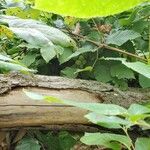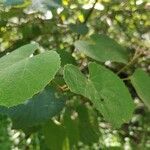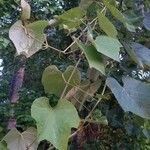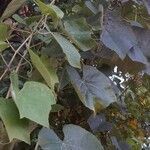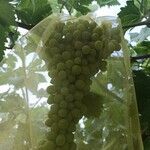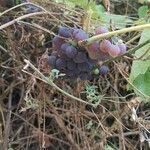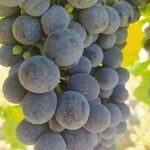High-climbing vine; pith interrupted at the nodes by a diaphragm; tendrils or infls from 3 or more successive nodes; lvs firm, round-cordate, 1–2 dm, usually shallowly 3-lobed, shallowly serrate, the lower surface persistently covered by a dense tomentum, this reddish or rusty when young, sometimes later fading to ashy-gray; peduncles and twigs eventually glabrous; panicles ovoid, 4–8 cm; fr dark red to nearly black, 1–2 cm; 2n=38. Woods, roadsides, and thickets; Me. to s. Mich., s. to S.C. and Tenn. Ancestor of the Concord and many other cult. grapes, including many hybrids, these collectively called V. labruscana L. H. Bailey and occasionally found as waifs.
A woody vine. It keeps growing from year to year. The young shoots are long and like felt. The leaves are large and 3 lobed. They are deep green above and like felt and white underneath. The leaves are leathery and 15-30 cm long. The flowers are in closely branched groups with male and female flowers in the same group. The fruit are large and purple-black. They are 2-3 cm across. They have a musky flavour.
A climbing plant. It is robust and woody. It loses its leaves in the winter. The leaves are variable. They are leathery and rough on top. The leaves are 14-28 cm long. The male and female flowers are in the same group. The fruit are round and thin skinned. They are sweet and juicy.
